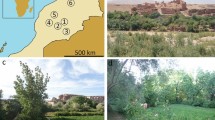Summary
Augochlorella striata was studied at the northern limit of its range. The study population contained a mixture of solitary and social nest foundresses. Eusocial foundresses produced 1 or 2 workers before switching to a male biased brood. Solitary foundresses produced males first. Cells vacated by eclosed offspring were reused late in summer. A female biased brood resulted from cell reuse in both solitary and eusocial nests. Workers were slightly smaller than their mothers and were sterile although most of them mated. In comparison to published data from a Kansas population of this species, the Nova Scotia population had i) a lower proportion of multiple foundress nests, ii) a smaller worker brood and iii) a briefer period of foraging activity but iv) comparable overall nest productivity.
Similar content being viewed by others
References
Billen J (1985) Ultrastructure of the worker ovarioles in Formica ants (Hymenoptera: Formicidae). Int J Insect Morphol Embryol 14:21–32
Boomsma JJ (1987) The empirical analysis of sex allocation in monogynous ants. In: Eder J, Rembold H (eds) Chemistry and biology of social insects. Peperny, Munich, pp 355–357
Boomsma JJ (1989) Sex-investment ratios in ants, has female bias been systematically overestimated? Am Nat 133:517–532
Eickwort GC (1969) A comparative morphological study and generic revision of the augochlorine bees. Univ Kans Sci Bull 58:425–524
Eickwort GC (1985) The nesting biology of the sweat bee Halictus farinosus in California, with notes on H. ligatus (Hymenoptera, Halictidae). Pan-Pac Entomol 61:122–137
Eickwort GC (1989) Distribution patterns and biology of West Indian sweat bees (Hymenoptera: Halictidae). In: Liebherr JK (ed) Zoogeography of Caribbean insects. Comstock, Ithaca, pp 214–230
Eickwort GC, Eickwort KR (1971) Aspects of the biology of Costa Rican Halictine bees, II. Dialictus umbripennis and adaptations of its caste structure to different climates. J Kans Entomol Soc 44:343–373
Eickwort GC, Kukuk, PF (1987) Reproductive castes in primitively eusocial Halictid bees. In: Eder J, Rembold H (eds) Chemistry and biology of social insects. Peperny, Munich, pp 261–262
Lorenzi MC, Turilazzi S (1986) Behavioural and ecological adaptations to the high mountain environment of Polistes biglumis bimaculatus. Ecol Entomol 11:199–204
Michener CD (1974) The social behavior of the bees. Belknap Press, Cambridge, MA
Michener CD, Bennett FD (1977) Geographical variation in nesting biology and social organization of Halictus ligatus. Univ Kans Sci Bull 51:501–538
Michener CD, Breed MD, Bell WJ (1979) Seasonal cycles, nests, and social behavior of some Colombian halictine bees (Hymenoptera: Apoidea). Rev Biol Trop 27:13–34
Ordway E (1965) Caste differentiation in Augochlorella (Hymenoptera; Halictidae). Insectes Soc 12:291–308
Ordway E (1966a) The bionomics of Augochlorella striata and A. persimilis in eastern Kansas. J Kans Entomol Soc 39:270–313
Ordway E (1966b) Systematics of the genus Augochlorella (Hymenoptera, Halictidae) north of Mexico. Univ Kans Sci Bull 46:509–624
Packer L (1986) The social organisation of Halictus ligatus (Hymenoptera; Halictidae) in southern Ontario. Can J Zool 64:2317–2324
Packer L, Knerer G (1985) Social evolution and its correlates in bees of the subgenus Evylaeus. Behav Ecol Sociobiol 17:143–149
Packer L, Knerer G (1986) The biology of a subtropical population of Halictus ligatus Say (Hymenoptera: Halictidae). I. Phenology and social organisation. Behav Ecol Sociobiol 18:363–375
Packer L, Jessome V, Lockerbie C, Sampson B (1989a) Phenology and social organisation of four sweat bees in a marginal environment: Cape Breton Island. Can J Zool 67:2871–2877
Packer L, Sampson B, Lockerbie C, Jessome V (1989b) Nest architecture and brood mortality in four Cape Breton sweat bees. Can J Zool 67:2864–2870
Plateaux-Quénu C (1974) Comportement de sociétés orphelines d'Evylaeus calceatus (Scop.) (Hym., Halictidae). Insectes Soc 21:5–12
Plateaux-Quénu C (1979) Qui remplace la reine dans un groupe d'ouvrières orphelines d'Evylaeus calceatus (Scop.) (Hym., Halictinae). Ann Sci Nat Paris 1:213–218
Richards KW (1973) Biology of Bombus polaris Curtis and B. hyperboreus Schönherr at Lake Hazen, Northwest Territories (Hymenoptera: Bombini). Quaest Entomol 9:115–157
Sakagami SF, Munakata M (1972) Distribution and bionomics of a transpalaearctic eusocial halictine bee, Lasioglossum (Evylaeus) calceatum, in northern Japan with reference to its solitary life cycle at high altitude. J Fac Sci Hokkaido Univ Ser 6: Zool 18:411–439
Sokal RR, Rohlf FJ (1981) Biometry. Freeman, New York
Yanega D (1988) Social plasticity and early-diapausing females in a primitively social bee. Proc Natl Acad Sci USA 85:4374–4377
Yanega D (1989) Caste determination and differential diapause within the first brood of Halictus rubicundus in New York (Hymenoptera: Halictidae). Behav Ecol Sociobiol 24:97–107
Author information
Authors and Affiliations
Rights and permissions
About this article
Cite this article
Packer, L. Solitary and eusocial nests in a population of Augochlorella striata (Provancher) (Hymenoptera; Halictidae) at the northern edge of its range. Behav Ecol Sociobiol 27, 339–344 (1990). https://doi.org/10.1007/BF00164004
Received:
Accepted:
Issue Date:
DOI: https://doi.org/10.1007/BF00164004




